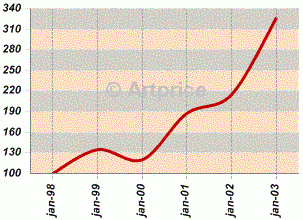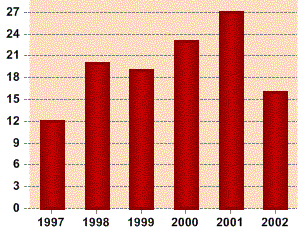Miquel Barceló (1957)
[29/01/2003]
The precocious Miquel Barceló has already conquered the auction market with his taste for mixing materials
Artworks at auctions
At the age of 20, Miquel BARCELO already had shows at the Mallorca Museum and a Barcelona gallery. Introduced to art at an early age by his mother — a painter in the style of the Mallorquin landscapists — and fascinated by art cru and abstract expressionism, he developed an early taste for variegated surfaces in his pictures, expressed in topography. In the 1980s, his now-figurative work took on a deliberately earthy tonality. Frequent travel, particularly in Africa, transformed his chromatic range and led him to integrate organic elements into his work, at the same time leading him into new subject matter, such as still lifes and landscapes. In the 1990s, one series followed another: the Toros (bullfight), the Workshops, the Sea. At the same time having been initiated into ceramic techniques in Mali, he painted and sculpted a number of works in bronze and terracotta. The market for Barceló’s work reflects his diverse production.
The market distinguishes between each of his periods, and his different series. The most sought-after works are his African landscapes from 1991 or the bull-fights of 1989. There is also a lot of interest in his workshop views of 1993 and his recent work, themed around the sea. But here we are only talking of his paintings. His output is extremely dense and includes some superb drawings and ceramics, a medium he turned to in the 1990s. More than half of the Barceló pieces sold at auction have been paintings, but prints and drawings make up another 46%. The variety of Barceló’s output is mirrored in the spread of prices. While only 50% of his lots have sold for less than EUR 20,000, collectors can still pick up numerous prints for less than EUR 1,000. Once prices started to rise, small studies flooded onto the market but it is getting ever more difficult to pick up a nice sketch for less than EUR 10,000.
The market places
London is now the top market for the artist’s work. Between 1992 and 2002, 85% of turnover was made in London. He has exhibited world-wide — the Museu d’Art Contemporani in Barcelona, Musée National d’Art Moderne in Paris, Timothy Taylor Gallery in London — and sponsored by world-name galleries, including Timothy Taylor, but also Leo Castelli Gallery/Soho in New York, La Caja Negra in Madrid and Lucio Amelio in Naples, and there are few auction markets in the world where Barceló has not made an appearance at auction. That said, enthusiasts are likely to find his most accessible pieces in France and Spain, the biggest market for Barceló prints..
Buy / sell
In the 1980s even his very large format works sold for under EUR 60,000. But now only a few minor works go for less than this. Of his paintings, 20% currently sell for less than EUR 30,000. Prices really took off in the last five years — EUR 100 invested in 1997 was worth an average EUR 326 in January 2003 — and the rise was vertiginous. In 2002 alone prices rose by 53%. A 191×100 cm canvas now goes under the hammer for EUR 139,000 compared to less than EUR 30,000 in 1997. The rise and rise of his paintings has driven strong growth in turnover at sales — up from less than EUR 500,000 in 1998 to nearly EUR 4 million in 2002 — despite little change in the number of lots sold. As an illustration, all five top prices seen at auction since 1992 have been made since 2000.
In 2002, Barceló had the market at his feet. Keen interest from collectors coincided with a sudden drop in the number of pieces put up for auction. With supply short, prices were driven upward. A bought-in ratio of less than 12% at auction (compared to 20% in 1998) means his works are still being snapped up and bids can spiral exponentially on the auction floor. This was clear from his latest record sale: Autour du Lac Noir went for a hammer price of £850,000 (EUR 1.3 million) on June 26, at Sotheby’s London. It had been estimated at EUR 300,000-600,000. But buying a Barceló work today seems unlikely to yield good investment returns. Prices have tripled in the last five years, growth is slow, and bidding in the auction rooms fiercely competitive. This leaves little prospect of bargains. That said, even if prices have dipped overall, anyone with a large-format Barceló form 1989-1990 has little to worry about. Not one put up for auction in the last ten years has failed to find a buyer. They have now become one of the artworld’s sure bets, sustained by unchanging demand. In ten years, the market for Barceló has firmed and become international.
Artprice Index base January 1998 = 100, all media categories, currency: EUR  Number of lots sold
Number of lots sold  Auction sales tunrover 1992-2002 / weight by country
Auction sales tunrover 1992-2002 / weight by country 




 0
0
